How to fly the American flag with respect
In 1942, President Franklin D. Roosevelt signed a bill into law, providing guidelines on how to fly the American flag with dignity and respect.
How to fly the American flag with respect
For over 70 years, the Federal Flag Code has stated the ideal ways to display Old Glory.
With its bold colors of red, white and blue, the American flag is arguably the most powerful symbol of the U.S.
A symbol often seen in a variety of places — from schoolhouse flag poles to football stadiums to battlefields and everything in between — the flag is something many folks enjoy displaying with pride.
In 1942, President Franklin D. Roosevelt signed a bill into law that provided guidelines on how Americans can respectfully fly Old Glory.
Respect for flag and country

File: Veterans of World War I on parade in 1978.
(James L. Amos / Corbis / Getty Images)
HOW DID WEATHER INFLUENCE WHEN THE D-DAY INVASION TOOK PLACE?
The guidelines for displaying and handling the U.S. flag are set by the Federal Flag Code, or Public Law 94-344.
According to the Federal Flag Code, the flag is "universally representative of the principles of the justice, liberty and democracy enjoyed by the people of the United States."
The flag itself is a symbol of the country, with the red and white stripes representing the 13 original colonies and the 50 white stars emblazoned on a blue field representing the 50 states. The latter is referred to as the "union".
Given the charged nature of its constituent parts, the flag has become federally protected. In fact, the Federal Flag Code states, "No disrespect should be shown to the flag of the United States of America."
Guidelines for flying Old Glory
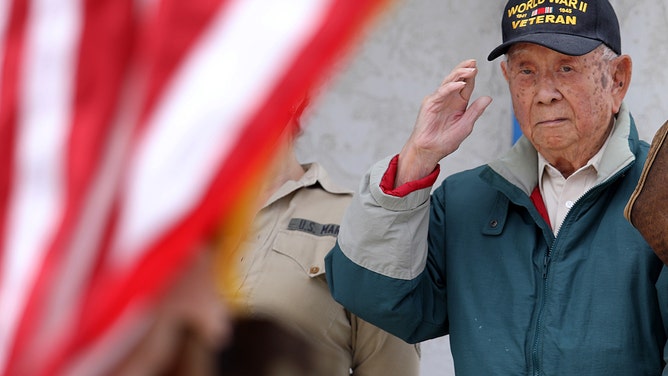
File: Louis Moore, a 98-year-old Chinese-American World War II veteran, salutes the presentation of the flags in 2021.
(Gary Coronado / Los Angeles Times / Getty Images)
THE HISTORY OF GEORGE WASHINGTON'S WEATHERVANE
The Federal Flag Code has a number of rules for how, when and where to display the flag with dignity. Here are some of those rules:
How to display the flag:
- The flag should be displayed with the union at the top and left from the perspective of a viewer.
- When hung on a wall with another flag, the U.S. flag must be displayed on the left side from a viewer’s perspective.
- When the flag is suspended over the middle of a street, it must be displayed vertically.
- When flown on the same staff with other flags, the U.S. flag must be at the top. Exceptions are made during church services conducted by Navy chaplains at sea.
WHEN THE NATIONAL PARK SERVICE WAS FOUNDED IN 1916
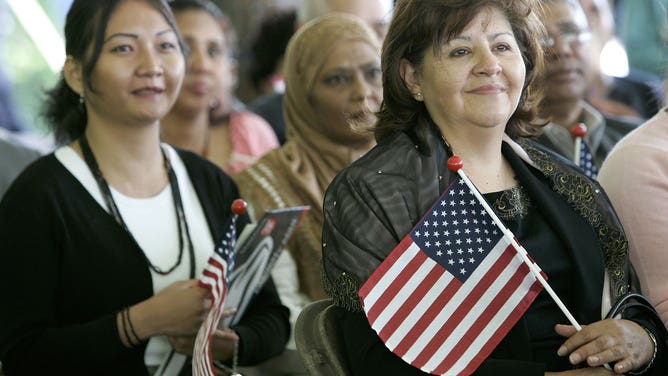
File: Holding U.S. flags, immigrants are sworn in as U.S. citizens during their citizenship ceremony.
(Alex Wong / Getty Images)
When to display the flag:
- The flag may only be displayed outdoors from sunrise to sunset. The flag may be displayed 24/7 only if the flag is constantly illuminated during darkness.
- The flag may not be displayed during inclement weather, such as rain, snow and windstorms, unless the flag is an all-weather flag.
- The flag should be displayed on all days, weather conditions permitting.
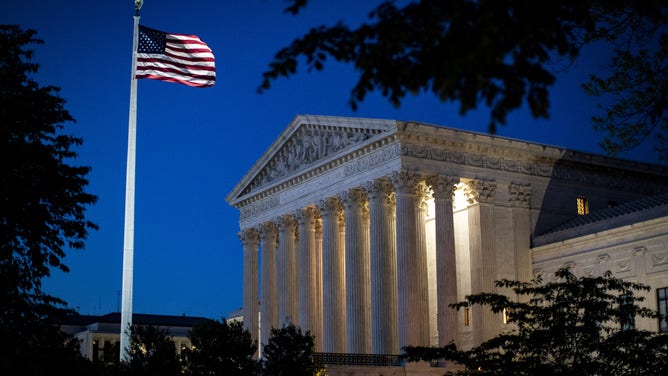
File: An American flag flies outside the U.S. Supreme Court as it stands illuminated at night.
(Al Drago/Bloomberg / Getty Images)
When to display flags at half-staff:
- The flag may be flown at half-staff to honor a federal or state government official who recently passed. This order may only be given by the president or governor.
- The flag should be flown at half-staff for 30 days from the death of the President or a former President and for 10 days from the day of death of the Vice President, the Chief Justice or a retired Chief Justice of the United States or the Speaker of the House of Representatives.
- The flag should be flown at half-staff until noon on Memorial Day.
5 WEATHER STORIES THAT ARE AS AMERICAN AS APPLE PIE
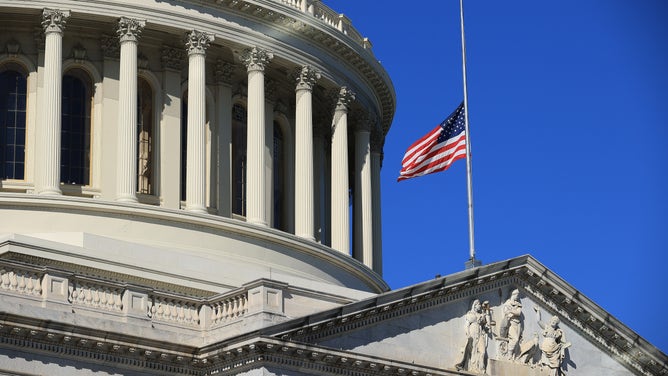
File: The American flag is flown at half-staff at the U.S. Capitol in honor of former Secretary of State Colin Powell.
(Chip Somodevilla / Getty Images)
Where to display the flag:
- The flag should be displayed on or near the main building of public institutions daily.
- The flag should be displayed on or near school buildings on school days.
- The flag should be displayed in or near polling places on election days.
HOW BATTLE REENACTMENTS BRING MILITARY AND WEATHER HISTORY TO LIFE
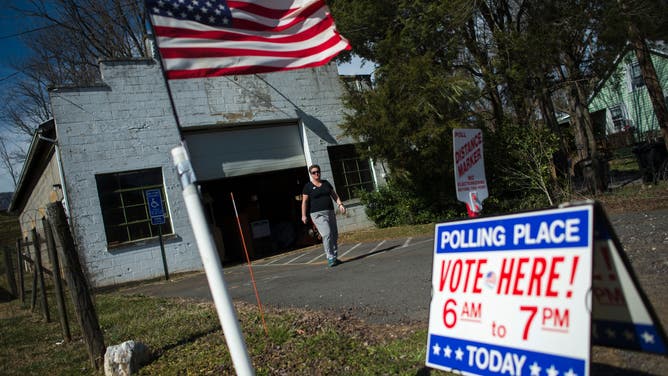
File: A flag flies in front of the Old Etlan rescue squad building, used as a county voting location in Etlan, Virginia during the 2016 Super Tuesday primary voting.
Practices to avoid with the flag:
- The flag should not be used as apparel, bedding or drapery.
- The flag may not be used for advertising or promotion purposes.
- The flag may not be printed on items intended for temporary use and then discarded.
- The flag may not be placed on the ground.
PEARL HARBOR ATTACK LED TO MULTI-YEAR BAN ON PUBLIC WEATHER DATA AS US ENTERED WORLD WAR II

File: Man eats a hamburger partially encased in a wrapper with a U.S. flag pattern.
(Ulrich Baumgarten / Getty Images)
How to retire a flag:
- A worn-out flag must be destroyed in a dignified way, preferably by burning.
Laws of the land
Despite these rules being an official federal law, the law does not explicitly state ways to enforce the rules. Because of this, it’s up to individual Americans to learn about and practice the rules voluntarily.
However, states may have their own flag codes and may enact penalties for mishandling of the flag.
One of the most controversial practices of handling the flag is flag burning (outside the purpose of retiring the flag).
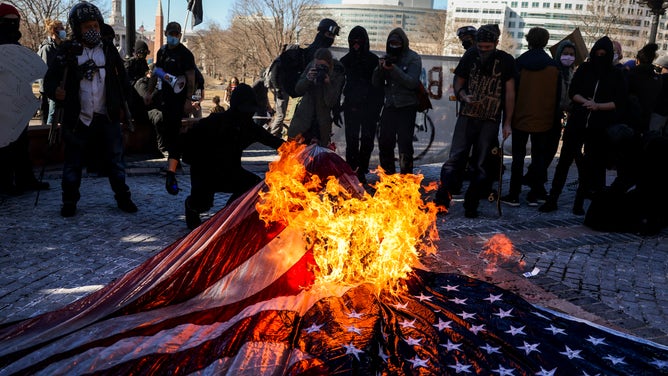
A U.S. flag is placed on the ground and set on fire.
(Michael Ciaglo / Getty Images)
HOW THE AMERICAN BISON BECAME A NATIONAL ICON
In 1989, Congress passed the Flag Protection Act, which fined and/or imprisoned people who knowingly desecrated the flag for up to one year. But in 1990, the law was struck down by the Supreme Court, which stated that the law violated the free speech protections provided by the First Amendment.
Aside from protocols on how to handle the flag, the Federal Flag Code also includes other rules, such as the standard design of the flag, how to recite the Pledge of Allegiance and how the flag should be placed over a casket.
The star-spangled banner

A U.S. Navy honor guard folds an American flag after removing it from the casket of a Vietnam War veteran.
(John Moore / Getty Images)
Much like the country, the U.S. flag has undergone a number of changes since its adoption as the nation’s official flag on June 14, 1777.
What began with 13 stars grew to 50, as more stars were added to reflect the changes and growth of the nation we know today — and with the Federal Flag Code, the flag can be flown with the respect deserving of the country it represents.
